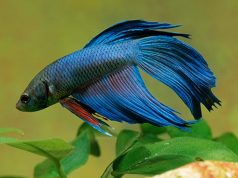The Albino Gene History
Back in 1953, first reported the finding of a true pink-eyed male albino betta fish. This Betta fish species appeared among a breeder’s stock, as many albinos do, by sheer accident. Thought at first to be a very pale specimen of the Cambodian type of betta, close inspection revealed the unnatural eyes and its true distinction. Naturally, it was given every consideration.
Only once before, in 1927, had such an albino been reported. This was by the veteran German aquarist Wilhelm Schreitmuller in Leipzig. He noticed it in a tank of tropical fish in the store of Herr W.Glaschter. With typical albino weakness, the German betta lived only a short time. It was preserved and presented to the Magdeburger Museum. It never was bred.

The one found in 1953, in spite of having difficulty seeing and an aversion to bright light, prospered and became robust. Three unsuccessful attempts were made to breed him in the normal manner. In spite of building a fine nest, he could not see the female unless she was directly in front of his nose. Because of this, his courting activities gradually dwindled.
Then a special breeding setup was attempted. It proved successful. The pair was confined together by means of a piece of glass in a small space with scarcely ten square inches of surface. Here the female could hardly escape his view. The courtship and eventual spawning were a success. Then it was discovered that the albino had no desire to care for the eggs. The nest broke up and scattered. The eggs dropped to the bottom unattended and went bad. Obviously, some other procedure was in order.
Once again the breeders were introduced into their limited confines. A second spawning ensued. As soon as it was completed, a three-inch laboratory Petri dish was slipped under the nest. It entrapped both eggs and the nest, and maintained but a fractional depth of water. This time most of the eggs survived. A small spawning of about fifty fry was reared.
The fry started to color when they were about five-eighths of an inch long. All were of a bluish-purple color. No hoped-for albinos were to be seen. This was expected. Albinism is a recessive characteristic. For the young to show it, the genes must be present in both parents. By the time these young had grown to breeding maturity, the male albino had perished, so a daughter could not be spawned back to him. As expected, brother-to-sister matings never resulted in another albino.
What had happened? Just one mistake and the albino betta again disappeared from the hobby. Thinking that the albino male had come from the early light-bodied Cambodian stock, a beautiful light-bodied female had been provided for the spawnings. Had the albino been derived from this stock, the offspring should have been of the Cambodian strain, also. Instead, the result was dark-colored offspring.
The results of future brother-to-sister matings should have been predictable on theoretical grounds. From each sixteen offspring, there should have appeared nine wild or dark-colored bettas, three Cambodian light-bodied fish, and four albinos.
There did appear mixed spawnings of light and dark specimens. However, the eye straining inspections failed to turn up another albino. Finally in 1994 a hobbyist named Tanaka successfully bred it.



